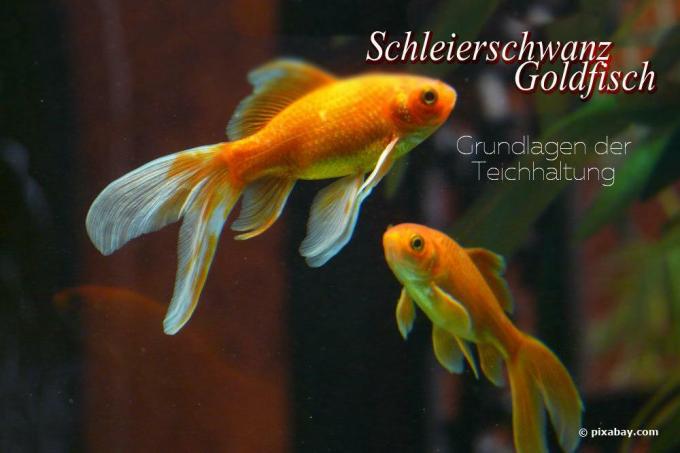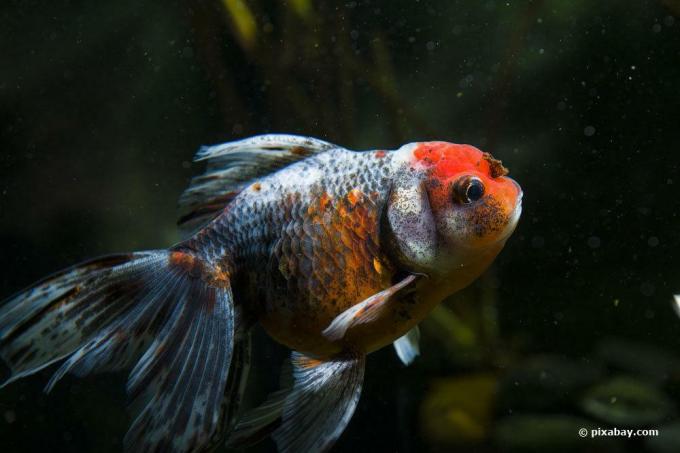
table of contents
- General needs
- Optimal living space
- Cultivated forms
- Suitable roommates
- Settlement
- Lining
- How much feed?
- Multiply
- Winter safely
- Diseases and parasites
A fish pond can be found in countless ornamental gardens, front gardens and other outdoor areas. One of its favorite inhabitants is the goldfish. Among the countless goldfish species, the veil tail occupies a special place because of its particularly handsome caudal fin. We explain how to keep the veil tail in the pond at home and with clear instructions we offer everything you need to know about settlement and the basics of keeping it.
General needs
Whether garden pond, aquarium or natural body of water - the goldfish of the species Carassius auratus, the veil tail, needs some general environmental conditions in order to be able to survive in the long term:
- Low water temperature between 4 ° C and 22 ° C
- Ideally clean, oxygen-rich water with a low proportion of suspended matter and other impurities
- pH of the water between 6.5 and 8.3
- Maximum nitrate content of the water 25 mg / l
- Degree of hardness of the water 10 to 12 dH
- Water depths around 100 to 150 centimeters
- Intensive sunbathing water is possible without any problems, as long as approx. 30% shaded water surface, e.g. B. in riparian zones
- The bottom of the water consists of a loose mixture of sand and gravel
- Life form as schooling fish, group sizes at least 4 to 6 animals
Optimal living space
If you already know the general requirements of the animals of the genus veil tail on their habitat, you can These foundations can easily be created in the form of a suitable garden pond by keeping the animals without significant problem can:
- Pond volume at least 1000 liters, correspondingly higher with large numbers of animals
- Minimum depth 100 to 150 centimeters, allow greater depths in exposed locations due to winter freezing
- Provide shaded water areas, e.g. B. by aquatic plants, greened Border areas with overhanging vegetation or surrounding trees
- Predominantly sandy or gritty Pond substrate choose, too high a soil content disadvantageous because of "pollution" of the pond water through nutrient release and suspended particles
- Good filter performance for high water quality, mechanical or natural filter (filter gravel, reed zone, etc.) possible
- Water quality as already described, if necessary check pH value and nitrate content with test strips and correct if necessary (pH increase / decrease, nitrate binder, etc.)
Cultivated forms
Similar to countless other ornamental fish, there are numerous different, sometimes heavily over-bred forms of the original veil-tailed goldfish. However, the extremely well-bred varieties in particular can only be kept in the limited environment of a garden pond with many disadvantages. Because through the intensive selection in the breeding process, there are many positive properties in relation to Resilience, adaptability and posture in general in favor of purely visual aspects neglected. Therefore, it makes sense to return to one of the original, less strongly modified forms of the veil tail:
Fan tails
- Also called "West Ryukin" because of its distribution in western countries
- Strong tapering of the caudal fin, accordingly less intense veil shape
- Uncomplicated in terms of reproduction in the garden pond
- Body sizes up to 20 centimeters possible
Attention: The fan tails show less variability in terms of water temperature. Although they can also overwinter without any problems, the water temperature should not be below 13 ° C during the active phases.

Ryukin
- is considered the oldest cultivated form of the veil tail
- very suitable for keeping in the garden pond
- high back shield with double fin
- very broad body appearance
- good winter skills
- faster swimmer, therefore more space required

Calico
- very original, not very one-sided cultivated form
- elongated physique, similar to classic goldfish
- characteristic pattern with white, black and red-orange spots
- is one of the breeding forms that are best adapted to pond management

tip: The closer a cultivated form of the veil-tailed goldfish is based on the "original" goldfish, the more robust and adaptable it is as a rule. With this background knowledge, even beginners in matters of keeping and breeding goldfish can easily avoid reaching for completely unsuitable forms of Carassius Auratus.
Suitable roommates
Since hardly a garden pond should be reserved for one form of life alone, the question sometimes arises as to which other animals harmonize well with the veil-tailed goldfish. Since this goldfish prefers relatively cool water, it is in combination with most of the established others Pond fish species difficult. Although the animals leave each other in peace, due to their different preferences, the prerequisites for coexistence are often not given. The socialization of the fan tail is known and widespread, therefore, only with a few, also cold-loving fish species:
- Moderlieschen
- minnow
- Bitterling
Problems with the compatibility with plants and other pond inhabitants, such as Shellfish or snails, on the other hand, are not known. As long as there is sufficient free water volume, nothing stands in the way of planting the pond.
Note: The common goldfish is unsuitable for keeping with the veil tail. This prefers the same framework conditions, but is superior in its swimming properties. In the long run he will therefore displace the veil tail with regard to food and preferred whereabouts.
Settlement
If the general conditions in the pond are correct and the other participants of the planned community have been found, the veil can move in. This is the best time to move in spring, because the generally more sensitive animals then have enough time to acclimate themselves in the new habitat before the most difficult phase, wintering. A slow acclimatization of the new residents usually succeeds very well with the following procedure and without too much stress for the fish:
- Wait for a minimum water temperature of 15 ° C
- First insert the transport bag with the fish on the edge of the pond
- After approx. Open the bag for 45 to 60 minutes, fill in some pond water and close it again
- Wait another 30 minutes, then open the bag and let the fish swim out by themselves
Lining
Although the goldfish is able to find its own food, the food supply in the limited volume of the garden pond is very limited. The external supply of food is therefore indispensable. Since the veil tail also accepts almost all types of food and seems to accept food offered at any time, there is a risk of pond fish, especially for beginners Overfeeding given. The result is overweight animals with a reduced life expectancy. The slower swimming behavior also makes them easy targets for predators such as birds, cats and martens. Well suited as food for the veil tail are:
- Ready-made fish food from specialist retailers, mostly available as dry food, frozen food or even live food
- Leaves of dandelion or lamb's lettuce as a nutritional supplement and as a distraction from existing aquatic plants
- Peas, corn and potatoes as additions to other food
The following procedures have proven to be expedient for the animals and the pond to carry out the feeding:
- Feeding only from a water temperature of 10 ° C, below which the animals are too active
- Distribute feed doses into two to three smaller doses per day, as a single dose has a high proportion of unused feed that pollutes the pond water
- Make one day a week feed-free
- Alternate different feeds in order to provide animals with comprehensive care and to keep them busy by changing the food supply

tip: Water fleas are considered to be the live food for the veil tail in general. The advantage of the live food is that animals that have not been eaten continue to live in the water and are eaten later. Dead food, on the other hand, sinks to the bottom of the pond and decomposes into substances polluting the water.
How much feed?
While determining the right type of feed is easy, determining the right amount of feed is far more difficult. It can vary greatly depending on the activity, size and number of animals. Here it is advisable to observe the pond closely at the beginning. If food remains in the pond, the dose should be reduced. If everything is eaten, the amount can be increased slightly. Finally, there should be a balance between supply and consumption.
Multiply
In the ideal case, the veil tail begins to multiply and reproduce itself after getting used to it in the pond. In this way, the population is preserved and there is no need to buy new animals. The nice thing is that the veil-tailed goldfish don't need any guidance to reproduce. If the ambient conditions are right, it will start reproducing by itself in spring. The presence of overgrown, shallow pond areas for oviposition is particularly important. Around a week after the eggs are laid, one to two millimeter large cubs hatch in black camouflage. Only after around 12 months do they develop the typical caudal fin and distinctive body color.
Attention: The biggest problem with the reproduction of this goldfish is cannibalism! It is therefore advisable to remove the newly hatched animals and raise them separately in a tank or aquarium. The risk of being eaten by older animals is a thing of the past and the young animals can go back to the pond when they are around four centimeters tall.
Winter safely
Once the first summer has passed, the animals prepare to overwinter in the pond. With decreasing water temperatures, they withdraw into the lower water layers and remain there in a state of calm. As a pond owner, you can specifically support this wintering process by creating the right conditions:
- Cut back green plants and protect the pond against leaves with a net in order to avoid fermentation gases through decomposition in the water
- Install an ozonizer at the bottom of the pond to ensure sufficient oxygen supply to the fish
- Provide an ice preventer on the surface to avoid complete freezing (extraction of fermentation gases from the water)
If the temperatures rise again in spring, the fish leave their winter quarters on their own and return to the active phase. From this point on, the feeding should be resumed and the necessary circulation should be provided in the pond with a pump.
Diseases and parasites
Carassius Auratus has hardly any typical, species-specific diseases. Only the obstruction of the intestines, which can be observed again and again in fish, due to a particularly one-sided diet, occurs faster and more frequently due to the physiological peculiarities. Otherwise he suffers from the well-known fungus, bacteria and parasite-related diseases that can generally occur in ponds and aquariums.
The best countermeasure is to provide a sufficiently large pond and ensure a good one Water quality in order to prevent the pathogens from developing and spreading as poorly as possible to prepare.
Tip: Watch your pond fish regularly to identify changes in behavior and appearance at an early stage. Both can be a sign of an illness and thus represent the starting signal for a successful fight.


